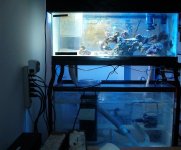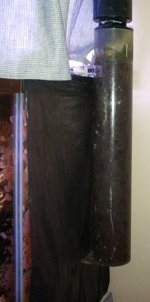And I would like to say that, knowing there would be a VAST myriad of opinions, I was indeed only joking. You said you had crude on the top of your tank, and I ran with it...you've never been to the beaches around Santa Barbara, have you? It certainly wasn't meant as anything personal, so my apologies if I offended. I'm not offended at all, though you do seem a bit cranky.

But no worries, yeah?
I spend a HUGE amount of time during my day, each day, answering questions (that's how
knucklehead and several others have found their way to this site). Not necessarily here, but I do help many, many people (answering much more directly, as well). Just go to
http://www.wetwebmedia.com and look into the Daily FAQ's. (I recently discovered my box was infected by the Sobig I-worm, so I've not been answering or doing
any work on the site for a few days.)
All that being said, to offer what you request, I respectfully disagree with you. I would strongly encourage a sump, and even go further and suggest a refugium. Yes, I have worked with VERY large systems (on the order of up to 1,000 - 1,500 gallons and larger) sans sumps. They're a pain in the arse, my friend. Systems so large that one must don bathing suit, mask, and snorkel just to vacuum the gravel and clean the tank walls (sing: Ain't no scraper long enough! Ain't no vacuum strong enough)! LOULE!! (And lemme tell ya, Emperor snappers--MEAN, puffers--if you're not careful you'll come outta there looking like you had a fight with a melon-baller, sharks--the pussies of the sea!)
I will not disagree with the statements regarding the surface slick of organics and whatnot, I have found an overflow, along with powerheads and spraybar outlets (pointed at the water's surface) to be one of the best ways to deal with this. Using a sump not only breaks the surface tension, it increases water flow and surface area, thus increasing the likelihood that you'll have good oxygen saturation.
Jo, I respectfully disagree with the statement calling biowheels and canister filters "nitrate factories". The reasons I take issue with this are:
1: It implies that utilization of other methods of nitrification and filtration will yield lower nitrate readings. This is not necessarily true.
2: I've had too many customers come in and say, "I'm not using x, y, or z, WHY have I got high nitrate readings anyway?"
There will only be significant buildup of nitrates if there were significant amounts of ammonia and nitrite to start off with, and nitrification
must happen, these other two compounds (wastes)
must be oxidized as they are quite toxic. Utilization of a DSB or other forms of natural nitrate reduction are what rectifies this situation best, in my opinion (yeah, I'll add in foam fractionation, as it will help remove certain compounds
before they break down...hopefully, assuming the thing is working properly). Hee! Anyhoo, outside of natural nitrate reduction, large, rather frequent water changes are the only other way to reduce nitrate buildup, which is going to happen whether these methods of filtration are used or not. I do hope I've made some sense here, I'm trying to be concise and succinct (yeah, right, who...ME? :roll: ). There are many who hold this idea of "nitrate factories", but in my honest opinion it belies a misunderstanding of the nitrification process and nutrient export.
My thanks again to
MickAv8r for introducing me to
Nitrospira bacteria. Must get link, must READ link, must be clear on what function
Nitrospira performs, as well as which
Nitro it is that
doesn't perform the nitrification we thought it did.... :| Must talk to Bob..







